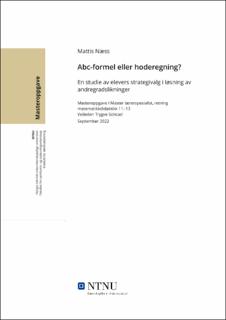| dc.contributor.advisor | Solstad, Trygve | |
| dc.contributor.author | Næss, Mattis | |
| dc.date.accessioned | 2022-11-10T18:21:43Z | |
| dc.date.available | 2022-11-10T18:21:43Z | |
| dc.date.issued | 2022 | |
| dc.identifier | no.ntnu:inspera:121329677:60527958 | |
| dc.identifier.uri | https://hdl.handle.net/11250/3031283 | |
| dc.description.abstract | I denne masteroppgaven har jeg analysert 59 elevers løsningsstrategier i arbeid med andregradsligninger. Jeg har analysert elevenes bruk av en hoderegningsstrategi (sum og produktmetoden) og en standardalgoritme (abc-formelen). Elevene i studien gikk første året på videregående skole og hadde valgt teoretisk matematikk. Hovedmålet med studien var å avdekke om innføringen av en hoderegningstrategi i tillegg til standardalgoritmen kunne hjelpe elevene til å bli gode på å tilpasse valg av løsningsstrategi til den oppgaven de skulle løse.
Etter å først ha utledet og fått opplæring i hoderegningstrategien og senere standardalgoritmen, fikk elevene opplæring i når de to metodene var mest egnet. Elevene gjennomførte deretter en test der de både fikk oppgaver som stimulerte dem til å bruke hoderegningstrategien, og oppgaver som stimulerte dem til å bruke standardalgoritmen. Testen besto av tre deler. På den første delen fikk elevene selv velge strategi, på del to ble elevene pålagt å benytte hoderegningstrategien - og på del tre ble elevene pålagt å benytte standardalgoritmen.
Resultatet av studien var at flertallet av elevene byttet mellom strategier og tilpasset strategiene til oppgavene de stod ovenfor. Flertallet av elevene valgte hoderegningstrategien oftere enn standardalgoritmen. Elevene viste også at de hadde utviklet en adaptiv strategi, nemlig at de først prøvde hoderegningstrategien og byttet til standardalgoritmen først når de så at hoderegningstrategien ikke fungerte.
Resultatene av studien viser at elever som har høy kompetanse på andre deler av matematikkpensum er mye mer adaptive i strategivalg enn elever med lavere matematikkompetanse. Likevel viser resultatene at også elevene med lav kompetanse, som hadde lært seg å tilpasse valg av strategi til oppgaven, gjør det bra på testen. Resultatene viser at elevene presterer bedre på oppgaver der de velger å bruke hoderegningstrategi enn på oppgaver der de velger å brukestandardalgoritmen. Dette til tross for at elevene behersker begge metodene like bra på oppgavene der de ikke kunne velge strategi.
Analysen og drøftingen av resultatene viser at innføringen av en hoderegningstrategi fører til at elevgruppen utvikler adaptive ferdigheter, og at disse ferdighetene hjelper elevene til å få en dypere forståelse av andregradsligninger. | |
| dc.description.abstract | In this master's thesis, I analyzed the adaptiveness of 59 Norwegian students in the use of a mental computation strategy (the sum and product method) and a standard algorithm (the quadratic formula) in solving quadratic equations. The students in this study were in their first year of high school (age 16) in theoretical mathematics class. The main objective of the study was to reveal whether learning a mental computation strategy could help the students to become better at adapting the choice of solution strategy to the task they were solving.
After first learning the mental computation strategy and later the standard algorithm, the students received specific training in when to use the different methods.
The students completed a test where they were given tasks that allowed them to use the mental computation strategy and tasks that allowed them to use the standard algorithm. The test consisted of three parts. In the first part, the students were allowed to choose their own strategy in the second part the students were required to use the mental computation strategy and in the third part the students had to use the standard algorithm.
The result of the study reveal that the majority of the students switched between strategies and adapted the strategies to the task. The majority of the students chose the mental computation strategy more often than the standard algorithm. The students also showed that they had developed an adaptive strategy, namely that they first tried the mental computation strategy and switched to the standard algorithm only when they realized that the mental computation strategy did not work. The results show that students who had high competence in other parts of the mathematics curriculum, were much more adaptive in their choice of strategy than students with lower mathematics competence. Nevertheless, the results show that those students with low competence who had learned to adapt the choice of strategy to the task, performed well on the test. The results show that students perform better on tasks where they chose the mental computation strategy than on tasks where they chose the standard algorithm, even though the students mastered both methods equally well in the no choice condition.
The analysis and discussion of the results show that the introduction of a mental computation strategy has led to the student group developing adaptive skills, and that these skills can help students gain a deeper understanding of quadratic equations. | |
| dc.language | nob | |
| dc.publisher | NTNU | |
| dc.title | Abc-formelen eller hoderegning
En studie av elevers strategivalg i løsning av andregradslikninger | |
| dc.type | Master thesis | |
